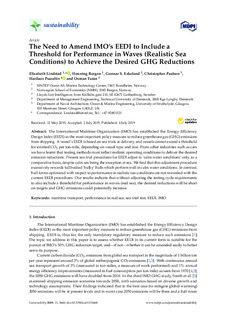| dc.contributor.author | Lindstad, Elizabeth | |
| dc.contributor.author | Borgen, Henning | |
| dc.contributor.author | Eskeland, Gunnar | |
| dc.contributor.author | Paalson, Christopher | |
| dc.contributor.author | Psaraftis, Harialos | |
| dc.contributor.author | Turan, Osman | |
| dc.date.accessioned | 2019-09-24T07:39:19Z | |
| dc.date.available | 2019-09-24T07:39:19Z | |
| dc.date.created | 2019-09-18T07:25:12Z | |
| dc.date.issued | 2019-07-04 | |
| dc.identifier.citation | Sustainability. 2019, 11 (13), . | nb_NO |
| dc.identifier.issn | 2071-1050 | |
| dc.identifier.uri | http://hdl.handle.net/11250/2618364 | |
| dc.description.abstract | The International Maritime Organization (IMO) has established the Energy Efficiency Design Index (EEDI) as the most important policy measure to reduce greenhouse gas (GHG) emissions from shipping. A vessel’s EEDI is based on sea trials at delivery, and vessels cannot exceed a threshold for emitted CO2 per ton-mile, depending on vessel type and size. From other industries such as cars we have learnt that testing methods must reflect realistic operating conditions to deliver the desired emission reductions. Present sea-trial procedures for EEDI adjust to ‘calm water conditions’ only, as a comparative basis, despite calm sea being the exception at sea. We find that this adjustment procedure excessively rewards full bodied ‘bulky’ hulls which perform well in calm water conditions. In contrast, hull forms optimized with respect to performance in realistic sea-conditions are not rewarded with the current EEDI procedures. Our results indicate that without adjusting the testing cycle requirements to also include a threshold for performance in waves (real sea), the desired reductions will be short on targets and GHG emissions could potentially increase. | nb_NO |
| dc.language.iso | eng | nb_NO |
| dc.rights | Navngivelse 4.0 Internasjonal | * |
| dc.rights.uri | http://creativecommons.org/licenses/by/4.0/deed.no | * |
| dc.subject | maritime transport | nb_NO |
| dc.subject | performance in real sea | nb_NO |
| dc.subject | sea trial test | nb_NO |
| dc.subject | EEDI | nb_NO |
| dc.subject | IMO | nb_NO |
| dc.title | The Need to Amend IMO’s EEDI to Include a Threshold for Performance in Waves (Realistic Sea Conditions) to Achieve the Desired GHG Reductions | nb_NO |
| dc.type | Journal article | nb_NO |
| dc.type | Peer reviewed | nb_NO |
| dc.description.version | publishedVersion | nb_NO |
| dc.rights.holder | © 2019 by the authors. Licensee MDPI, Basel, Switzerland. This article is an open access article distributed under the terms and conditions of the Creative Commons Attribution (CC BY) license | nb_NO |
| dc.source.pagenumber | 17 | nb_NO |
| dc.source.volume | 11 | nb_NO |
| dc.source.journal | Sustainability | nb_NO |
| dc.source.issue | 13 | nb_NO |
| dc.identifier.doi | 10.3390/su11133668 | |
| dc.identifier.cristin | 1725960 | |
| dc.relation.project | Norges forskningsråd: 237917 | nb_NO |
| cristin.unitcode | 7566,7,0,0 | |
| cristin.unitname | Energi og transport | |
| cristin.ispublished | true | |
| cristin.fulltext | original | |
| cristin.qualitycode | 1 | |

